I have spent a lot of blogs talking about all the exciting projects of governments and private companies in the exploration and exploitation of space. Three quarters the three hundred and thirty billion dollar space economy represents commercial investment as private firms rush to exploit the "High Frontier." Unfortunately, there are serious challenges that are increasing the expense of launching and protecting satellites.
Commercial networks are rapidly expanding their use of satellite communication which makes them tempting targets for hackers. There are individuals and groups that are working to illegally exploit space hardware. Hackers are attracted to both the communication hardware itself as well as the information that is being transmitted. Satellites in Earth orbit are becoming a battleground between security groups and hackers. The technology for space exploration is very sophisticated and proprietary design information is a tempting target for hackers working for other companies. Hackers are carrying out corporate espionage and other types of cyber attacks in order to gain commercial advantages over competitors.
Space hardware manufacturers are forced to spend money to prevent malicious software from being loaded onto their hardware before it is even launched. The rapid growth of the space hardware market has attracted some unscrupulous players. A lot of the manufacturing is being done in Asia which make it more difficult for American and European companies to closely monitor the behavior of companies they are dealing with. At the annual meeting of the International Astronautical Conference in Israel last week, a representative of the European Space Agency discussed hardware that the ESA had purchased that turned out to have been tampered with to allow hackers to gain access to the satellite after it had been launched.
There is so much debris from space launches and old satellites in orbit that it is becoming a serious threat to satellite launches. There are about half a million pieces of space junk in Earth orbit that are roughly the size of a child's marble. Twenty thousand more pieces the size of baseballs are also in orbit. This junk is racing around the Earth at about ten times the speed of a bullet. There is a general understanding that satellites should be constructed and launched in such a way that they will reenter the Earth's atmosphere and burn up on their own within twenty five years. However, there is no guarantee that current satellites being launched will follow this understanding.
If the cloud of space debris gets much denser, it will be more difficult to launch satellites. This will increase launch costs. There are companies that are viewing this problem as a new business opportunity. Removal of space debris could become a lucrative market in the future. There are suggestions for systems that employ robotic arms, nets, harpoons, surfaces with adhesives and even robotic tentacles that could either drop the debris for burn up or move it into a unused orbit where it would be less of a threat.
There is about a ten percent chance of failure in satellite launches from a variety of sources. This has resulted in an insurance market for space ventures where about ten percent of the cost of a satellite is charged for insuring a launch. This is the third highest cost for space entrepreneurs behind construction and launching. Insurance against hacking is not currently part of the space insurance market but some insurance companies are considering it.
